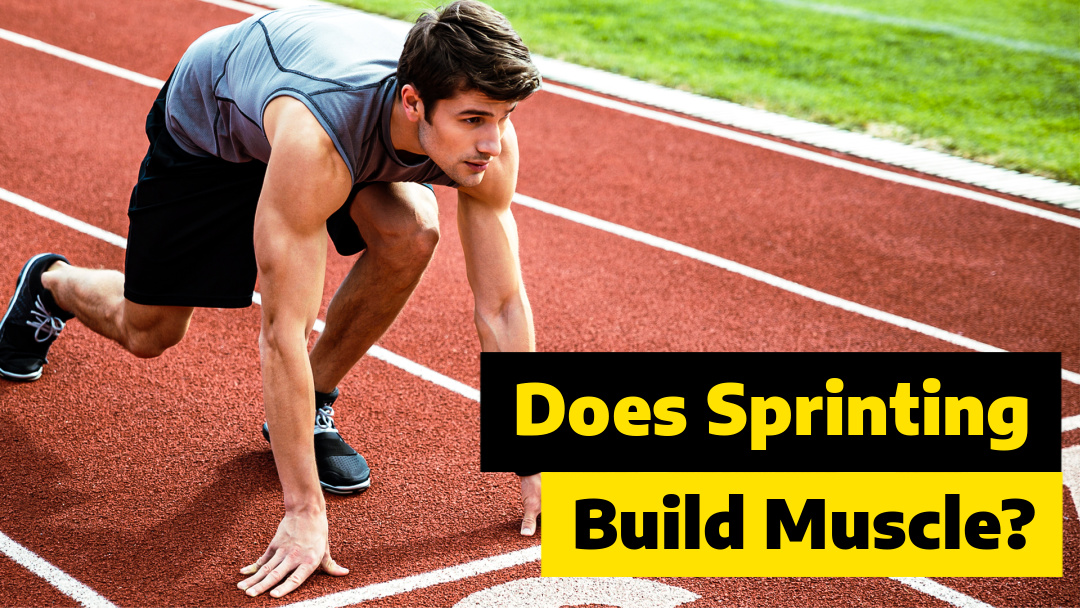Have you ever wondered if sprinting can help you build muscle? Many fitness enthusiasts, athletes, and individuals looking to improve their physique are curious about the potential muscle-building benefits of sprinting.
In this comprehensive guide, we’ll delve into the science behind sprinting and muscle growth, explore the relationship between sprinting and muscle building, and discuss the benefits, techniques, and potential challenges of sprinting for muscle development.
So, let’s lace up our running shoes and dive into the world of sprinting!
Understanding Sprinting
What is sprinting?
Sprinting is a form of high-intensity running that involves giving your maximum effort for a short distance. It’s not just about running fast; it’s about explosive power, rapid acceleration, and maintaining a high speed for a brief period. Unlike long-distance running, which focuses on endurance, sprinting emphasizes quick bursts of energy.
How does sprinting differ from other forms of running?
Sprinting is distinct from other forms of running in terms of intensity, duration, and purpose. While jogging or long-distance running primarily targets cardiovascular endurance, sprinting places a greater emphasis on power, speed, and muscle activation. Sprinting engages fast-twitch muscle fibers, which have a higher potential for muscle growth and strength development.
The science behind sprinting
When you sprint, your body undergoes a series of physiological changes. The explosive muscle contractions required for sprinting stimulate the production of anabolic hormones, such as testosterone and growth hormone. These hormones play a crucial role in muscle growth and repair. Sprinting also triggers the release of endorphins, which contribute to the feeling of exhilaration commonly associated with high-intensity exercise.

Muscle Building Basics
How does muscle growth occur?
To understand how sprinting builds muscle, it’s important to grasp the basics of muscle growth. When you subject your muscles to intense exercise, such as sprinting, microscopic damage occurs to the muscle fibers. This damage initiates a process called muscle protein synthesis, where your body repairs and rebuilds the damaged fibers, making them stronger and larger.
Factors influencing muscle growth
Several factors influence muscle growth, including genetics, nutrition, training intensity, and recovery. While sprinting can stimulate muscle growth, it’s crucial to consider these factors holistically to optimize your muscle-building potential. Consistency, proper nutrition, and adequate rest play vital roles in maximizing the benefits of sprinting for muscle development.
Different types of muscle fibers
Muscles are composed of different types of muscle fibers, namely Type I (slow-twitch) and Type II (fast-twitch) fibers. Type I fibers are more resistant to fatigue and are primarily used during endurance activities. In contrast, Type II fibers are responsible for explosive movements and are the primary focus during sprinting. By engaging these fast-twitch muscle fibers through sprinting, you can target and develop them for greater muscle growth.
The Relationship Between Sprinting and Muscle Building
Sprinting as a muscle-building exercise
Sprinting is an excellent muscle-building exercise due to its high-intensity nature. When you sprint, multiple muscle groups throughout your body are activated, including the quadriceps, hamstrings, glutes, calves, core, and upper body. This comprehensive engagement of muscles leads to increased muscle recruitment, which can stimulate hypertrophy (muscle growth) over time.
Muscle groups targeted during sprinting
Sprinting primarily targets the lower body muscles, including the quadriceps (front of the thigh), hamstrings (back of the thigh), glutes (buttocks), and calves. These muscle groups work together to generate the force needed for explosive acceleration and powerful strides. Additionally, sprinting also engages the muscles of the core and upper body, which contribute to stability and efficient movement.
Sprinting vs. traditional strength training for muscle growth
While traditional strength training exercises like weightlifting and resistance training are effective for muscle growth, sprinting offers a unique set of benefits. Sprinting is a functional movement that closely mimics real-life activities, such as running, jumping, and changing direction rapidly. It enhances coordination, agility, and power while simultaneously promoting muscle development.
Benefits of Sprinting for Muscle Building
Increased testosterone production
One significant benefit of sprinting is its impact on testosterone production. Testosterone is a hormone that plays a crucial role in muscle growth, strength, and overall athletic performance. High-intensity exercises like sprinting have been shown to stimulate testosterone production, creating an environment conducive to muscle development.
Enhanced muscle hypertrophy
By engaging the fast-twitch muscle fibers, sprinting can promote muscle hypertrophy. The explosive nature of sprinting places a significant demand on the muscles, triggering the growth and adaptation necessary for increased strength and size. Sprinting can help sculpt lean muscle mass and contribute to a more athletic physique.
Improved cardiovascular health
In addition to building muscle, sprinting also offers significant cardiovascular benefits. Regular sprinting workouts can improve heart health, increase lung capacity, and enhance overall cardiovascular fitness. The combination of explosive bursts and recovery periods challenges the cardiovascular system, leading to greater efficiency and endurance.
Boosted metabolism and fat loss
Sprinting is an effective tool for fat loss due to its impact on metabolism. High-intensity exercises like sprinting elevate the metabolic rate and create an “afterburn” effect, where your body continues to burn calories at an increased rate even after your workout. This can contribute to overall fat loss and help reveal the muscle definition you’ve been working hard to build.
Overall athletic performance improvement
Sprinting is not only about muscle building but also about enhancing overall athletic performance. The explosive power, speed, and agility developed through sprinting can translate to improved performance in various sports and physical activities. Whether you’re an athlete aiming to enhance your performance or an individual looking to elevate your fitness level, sprinting can be a valuable addition to your training regimen.
Sprinting Techniques for Muscle Building
Warm-up and stretching
Before engaging in sprinting, it’s essential to warm up your muscles and perform dynamic stretching exercises. A proper warm-up prepares your body for the intense effort ahead, reduces the risk of injury, and enhances performance. Incorporate exercises like jogging, leg swings, lunges, and hip rotations to loosen up the muscles and increase blood flow.
Proper sprinting form
Maintaining proper form while sprinting is crucial for maximizing its muscle-building benefits and minimizing the risk of injury. Focus on maintaining an upright posture, driving your arms with each stride, and landing on the balls of your feet. Avoid overstriding, as it can put excessive stress on the joints and hamper your performance.
Intensity and duration
To stimulate muscle growth, it’s important to challenge your muscles during sprinting. Gradually increase the intensity by sprinting at your maximum effort for shorter distances initially, and then gradually progress to longer distances as your fitness level improves. Remember to maintain proper form and avoid sacrificing technique for speed.
Incorporating sprint intervals
One effective way to optimize muscle growth through sprinting is to incorporate interval training. Interval training involves alternating between periods of high-intensity sprinting and active recovery. For example, sprint at maximum effort for 30 seconds, followed by a 60-second recovery period of jogging or walking. This method allows you to push your limits during the sprints while still allowing adequate recovery.
Recovery and rest periods
Proper recovery and rest periods are crucial for muscle growth and injury prevention. Allow your muscles sufficient time to rest and repair between sprinting sessions. Adequate sleep, proper nutrition, and active recovery techniques like stretching, foam rolling, and low-impact exercises can aid in recovery and optimize muscle-building results.

Sprinting and Diet for Muscle Building
Importance of nutrition
Nutrition plays a vital role in muscle building, and sprinting is no exception. To support muscle growth and repair, ensure you’re consuming a well-balanced diet that includes an adequate amount of protein, carbohydrates, and healthy fats. Protein is particularly important for muscle repair, while carbohydrates provide the energy needed for intense sprinting workouts.
Macronutrient ratios
The specific macronutrient ratios may vary depending on individual goals and preferences. However, a general guideline for muscle building is to consume approximately 1.2 to 2 grams of protein per kilogram of body weight, along with sufficient carbohydrates and healthy fats. Incorporate lean protein sources like chicken, fish, tofu, and legumes, along with whole grains, fruits, vegetables, and nuts.
Pre- and post-sprint meal suggestions
Fueling your body before and after sprinting is essential for optimizing performance and muscle recovery. Prior to sprinting, consume a balanced meal or snack that includes easily digestible carbohydrates and a moderate amount of protein. Examples include a banana with Greek yogurt or a whole grain toast with peanut butter.
After your sprinting workout, focus on replenishing your energy stores and providing your muscles with the nutrients they need to recover. Include a post-workout meal or snack that combines carbohydrates and protein. Some options include a protein shake with a banana, grilled chicken with quinoa and vegetables, or a smoothie with berries and Greek yogurt.
Hydration tips for sprinters
Staying hydrated is crucial for performance, recovery, and overall health during sprinting. Drink water regularly throughout the day to maintain proper hydration levels. Before your sprinting session, consume an adequate amount of water to ensure you’re hydrated. During and after your workout, listen to your body’s thirst cues and replenish fluids accordingly.
Potential Challenges and Considerations
Overtraining and injury prevention
While sprinting can be highly beneficial for muscle building, it’s important to avoid overtraining and prevent injuries. Overtraining occurs when you push your body beyond its ability to recover, leading to fatigue, decreased performance, and an increased risk of injuries. Allow yourself sufficient rest days between sprinting sessions and listen to your body’s signals of fatigue or pain.
Balancing sprinting with other workouts
If you’re incorporating sprinting into your overall fitness routine, it’s essential to strike a balance with other types of exercises. Incorporate strength training exercises to target muscles that may not be fully engaged during sprinting. Additionally, incorporate flexibility training and low-impact exercises to maintain joint mobility and prevent imbalances.
Adaptation for different fitness levels
Sprinting can be adapted to different fitness levels, from beginners to advanced athletes. If you’re new to sprinting, start gradually with shorter sprints and longer recovery periods. As your fitness improves, gradually increase the intensity and duration of your sprints. Consult with a fitness professional if you need guidance on how to tailor sprinting to your specific fitness level and goals.

FAQs
How are sprinters so muscular?
Sprinters develop muscular physiques due to a combination of factors. Sprinting engages multiple muscle groups, stimulating muscle growth. Additionally, the explosive nature of sprinting triggers the release of anabolic hormones, such as testosterone and growth hormone, which promote muscle development. Finally, sprinters often incorporate strength training exercises to further enhance their muscle mass and power.
How long does it take to see results from sprinting?
The timeline for seeing results from sprinting can vary depending on individual factors such as fitness level, consistency, and nutrition. However, with regular sprinting workouts and a balanced diet, noticeable improvements in muscle tone, strength, and overall fitness can be observed within a few weeks to a couple of months.
Will sprinting get me ripped?
Sprinting, when combined with a proper diet and overall fitness regimen, can contribute to achieving a ripped physique. Sprinting helps build lean muscle mass while burning fat, resulting in a more defined and sculpted appearance. However, it’s important to note that individual results may vary, and consistency and dedication are key.
Does sprinting flatten your stomach?
Sprinting can contribute to a flatter stomach by promoting overall fat loss. High-intensity exercises like sprinting elevate the metabolic rate, leading to increased calorie burn and fat reduction. However, it’s essential to combine sprinting with a healthy diet and targeted abdominal exercises for optimal results.
Does sprinting increase leg size?
Sprinting can contribute to increased leg size due to the activation and development of the lower body muscles, including the quadriceps, hamstrings, and calves. However, genetics, overall training regimen, and nutrition also play significant roles in determining muscle size. Consistent sprinting workouts, combined with proper nutrition, can lead to more muscular and defined legs.
How often should I sprint to build muscle?
The frequency of sprinting workouts depends on various factors, including your fitness level, recovery ability, and overall training program. Generally, incorporating two to three sprinting sessions per week, with adequate rest and recovery days in between, can be effective for muscle-building purposes. It’s important to listen to your body and adjust the frequency based on your individual needs.
Can sprinting be done by beginners?
Yes, sprinting can be done by beginners, but it’s important to start gradually and progress at a comfortable pace. Begin with shorter sprints and longer recovery periods, allowing your body to adapt to the demands of sprinting. As your fitness level improves, you can gradually increase the intensity and duration of your sprints.
Can sprinting help with weight loss?
Yes, sprinting can aid in weight loss. High-intensity exercises like sprinting elevate the metabolic rate, leading to increased calorie burn both during and after the workout. The combination of intense bursts of effort and recovery periods challenges the body and promotes fat loss. When combined with a balanced diet, sprinting can be an effective tool for weight management.
Can sprinting improve athletic performance in other sports?
Yes, sprinting can have a positive impact on athletic performance in other sports. The explosive power, speed, and agility developed through sprinting can translate to improved performance in activities that require quick bursts of energy, such as basketball, soccer, tennis, and football. Sprinting enhances overall athleticism, coordination, and body control.
Conclusion
Sprinting is not only a powerful tool for building muscle but also a dynamic and challenging form of exercise that enhances overall athleticism and fitness. By incorporating sprinting into your training regimen, you can stimulate muscle growth, increase testosterone production, improve cardiovascular health, boost metabolism, and enhance your athletic performance.
Remember to warm up properly, maintain proper sprinting form, gradually increase intensity, and allow for sufficient rest and recovery. Pair sprinting with a well-balanced diet that supports muscle development, and consider the potential challenges and considerations to ensure safe and effective workouts.
Whether you’re a beginner or an experienced athlete, sprinting can be a valuable addition to your fitness journey, helping you achieve your muscle-building and performance goals.


Recent Comments